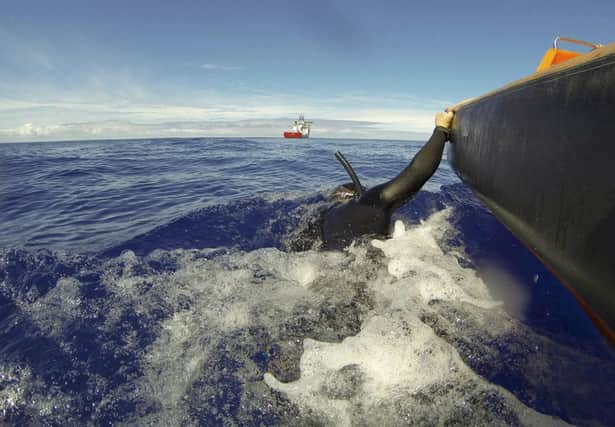Search for Malaysia flight ‘pings’ draws a blank


The signals were first heard late Saturday and early Sunday had sparked hopes of a breakthrough in the search for the plane.
Angus Houston, the retired Australian air chief marshall leading the search off western Australia, said listening equipment on the Ocean Shield ship has picked up no trace of the sounds since then.
Advertisement
Hide AdAdvertisement
Hide AdFinding the sound again is crucial to narrowing the search area so a submarine can be deployed to chart a potential debris field on the seafloor. If it was used now with the sparse data collected so far, covering all the potential places from which the pings might have come would take many days.
Mr Houston said: “It’s literally crawling at the bottom of the ocean so it’s going to take a long, long time.”
The locator beacons on the black boxes have a battery life of about a month – and Tuesday marked exactly a month since the plane vanished. Once the beacons blink off, locating the black boxes in such deep water would be an immensely difficult, if not impossible, task.
Mr Houston added: “There have been no further contacts with any transmission and we need to continue [searching] for several days right up to the point at which there’s absolutely no doubt that the batteries will have expired.”
If, by that point, the United States Navy’s pinger locator has failed to pick up more signals, the submarine will be deployed. If it maps out a debris field on the ocean floor, the sonar system on board will be replaced with a camera unit to photograph any wreckage.
Mr Houston earlier said the two sounds heard at the weekend are consistent with the pings from an aircraft’s black boxes, which are expected to run out of power very soon.
Australian defence minister David Johnston said the sounds were the most positive lead and were being pursued vigorously.
He added: “We’re very hopeful we will find further evidence that will confirm the aircraft is in that location. There’s still a little bit of doubt there, but I’m a lot more optimistic than I was one week ago.”
Advertisement
Hide AdAdvertisement
Hide AdOfficials warned it could take days to determine whether the sounds were connected to the plane that vanished on 8 March during a flight from Kuala Lumpur to Beijing with 239 people on board.
Mr Johnston said: “This is an herculean task – it’s over a very, very wide area. The water is extremely deep. We have at least several days of intense action ahead of us.”
Meanwhile, at a hotel in Beijing where about 300 relatives of the flight’s passengers – most of whom were Chinese – continued to wait for information about the plane’s fate.
One family lit candles on a heart-shaped cake to mark what would have been the 21st birthday of passenger Feng Dong, who had been working in construction in Singapore for the past year and was flying home to China via Kuala Lumpur.
A family member of another passenger said staying together allowed the relatives to support each another.
Steve Wang said: “If we go back to our homes now it will be extremely painful. We have to face a bigger pain of facing uncertainty, the unknown future. This is the most difficult to cope with.”
Investigators have not found any explanation as to why the plane lost communications and veered far off its Beijing-bound course, so the black boxes containing the flight data and cockpit voice recorders are key to learning what went wrong.